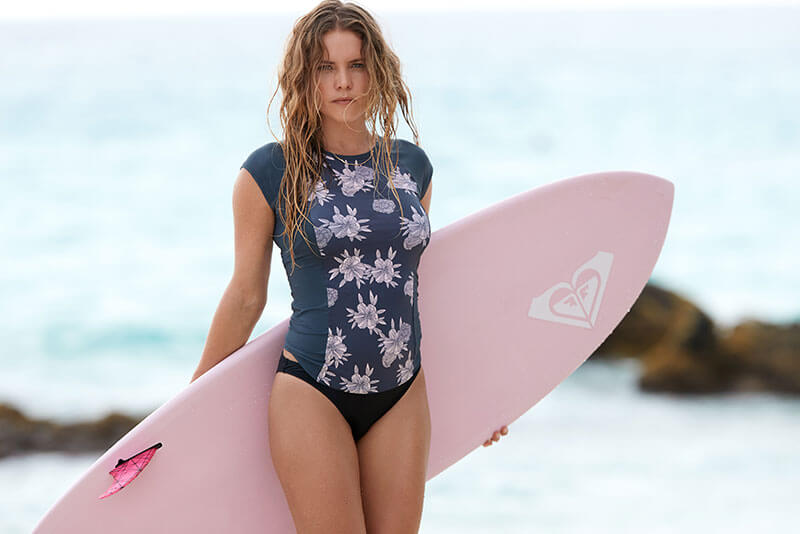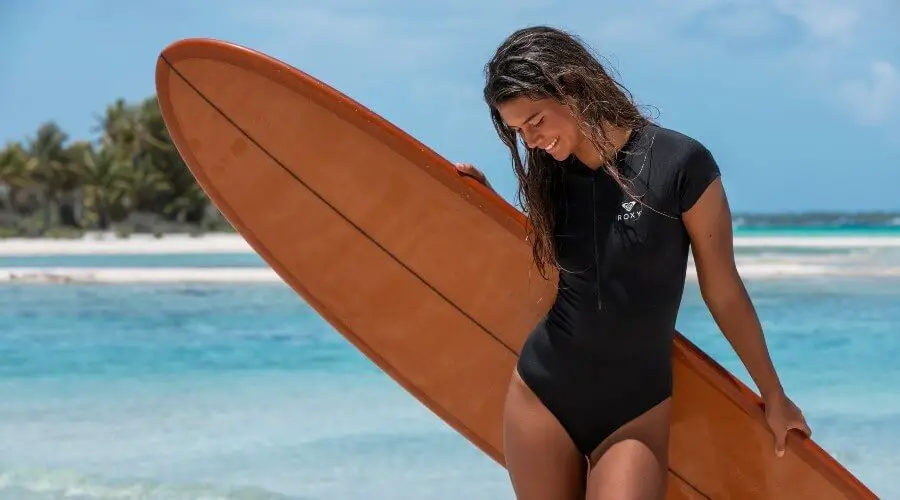Last Updated on August 16, 2023 By Emma W. Thomas
Rash guards, worn in water activities, offer UV protection due to UPF ratings (typically 30-50+). They reduce skin irritation and chafing from boards and sand. Made from stretchy, quick-drying fabrics, they fit snugly to prevent riding up. Ideal for surfing, swimming, and water sports.
What Does A Rash Guard Do?
- Protection from Sun’s Harmful Rays:
Rash guards provide robust protection against the harmful ultraviolet (UV) rays of the sun. The high-tech fabrics used in rash guard construction usually offer an ultraviolet protection factor (UPF) of 50+, which blocks over 98% of the harmful UVA and UVB rays. - Prevention of Skin Rashes:
As the name suggests, rash guards help prevent skin rashes caused by various factors such as skin abrasion, with frequent contact between your skin and the surfaces of sport equipment or sand on the beach. - Enhanced Performance in Water Sports:
In water sports like surfing and swimming, rash guards improve performance due to their compression benefits and hydrodynamic properties. They provide muscle support and reduce drag in the water, making movements smoother and quicker. - Thermal Insulation:
Rash guards offer thermal insulation, keeping the body warmer in cold water or during dive sessions. It helps delay the onset of hypothermia in colder waters by maintaining body heat. - Abrasion and Impact Protection:
Rash guards provide a certain level of protection against minor abrasions or impacts received during water sports or other physical activities, reducing the susceptibility to bruises or cuts. - Ideal for Layering:
When worn under wetsuits, rash guards help ensure comfort by avoiding uncomfortable friction between the skin and the wetsuit material. It makes putting on and taking off a wetsuit easier and less time-consuming.
| Number | Benefit | Description |
|---|---|---|
| 1 | UV protection | Rash guards block over 98% of harmful UVA and UVB rays. |
| 2 | Skin rash prevention | They prevent rashes caused by skin-surface or equipment surface friction. |
| 3 | Enhanced performance | Rash guards provide muscle support and reduce drag in the water. |
| 4 | Thermal Insulation | They offer thermal insulation, preventing hypothermia in colder waters. |
| 5 | Impact protection | Rash guards protect against minor abrasions and impacts during activities . |
| 6 | Ideal for layering | They make wearing a wetsuit more comfortable by reducing friction. |
What Do You Wear Under A Rash Guard?

1. Nothing
For some surfers and swimmers, wearing nothing underneath the rash guard is often the norm. This approach provides one with the level of comfort they prefer when wading, swimming, or surfing in the water. However, it’s only advisable if the rash guard is thick enough to prevent irritations.
2. Swim Shirts
A swim shirt can be worn underneath a rash guard for additional protection against UV radiation. This option is highly suitable for individuals sensitive to sunlight or those intending to stay in water for extended periods.
3. Swimming Trunks or Bathing Suits
Trunks and bathing suits can come in handy underneath a rash guard particularly when swimming in public places. It allows for decency and convenience especially when you need to remove the rash guard.
4. Bikinis or Swim Briefs
For a more stylish outlook, many individuals opt for bikinis or swim briefs under their rash guard. Besides style, these outfits provide flexibility, thus allowing you to indulge in various activities like beach volleyball or body boarding.
5. Swim Jammers or Board Shorts
These are perfect for offering extra coverage and support under the rash guard. They are comfortable for long periods in the water and are commonly used among competitive swimmers and surfers.
6. Wetsuit
In cold weather conditions, wearing a wetsuit under your rash guard can help maintain your body temperature. Wetsuits are designed to insulate against cold water by retaining a thin layer of water against your skin, which your body warms up.
7. Compression Shorts
Worn mainly for comfort and support, compression shorts reduce muscle strain and fatigue. Their snug fit ensures they stay put, allowing free movement without any discomfort or restriction.
| Clothing Option | Benefits |
|---|---|
| Nothing | Provides comfort |
| Swim shirts | Protects against UV rays |
| Swimming trunks or bathing suits | Ensures decency |
| Bikinis or swim briefs | Offers style and flexibility |
| Swim jammers or board shorts | Provides extra coverage |
| Wetsuit | Insulates against cold water |
| Compression shorts | Reduces muscle strain |
How Should A Rash Guard Fit?
Rash guards are designed to fit snugly and conform to your body’s shape. A loose-fitting rash guard will rub and cause chaffing on your skin, making it counter-effective. If you do not like a tight rash guard, opt for a swim shirt rash guard or look for one that is stretchy.
What Is The Difference Between A Rash Guard And A Wetsuit?
While both are designed for safety and comfort in water sports, they are very different. A wetsuit is ideal for swimming in cold water since it is heat-insulated while a rash guard protects you from rashes and irritation. A rash guard is often worn under a wetsuit to reduce friction and irritation.
Benefits Of Wearing A Rash Guard
Rash guards are a bit pricier compared to regular swim shirts, but they are absolutely worth the fuss. Here are some advantages of wearing rash guards when going for water adventures;
1. Prevents Rashes And Skin Abrasions
The main reason for wearing rash guards is to protect your skin from rashes and irritation. When surfing or swimming, sand comes into contact with our bodies, causing friction and irritation. Rash guards are designed to fit tight onto our skin, thus preventing friction. Saltwater is also a common irritant to the skin, and experts advocate for wearing rash guards in such waters. If you plan on wearing a wet suit for long hours, you might as well need a rash guard. Body movements and long periods of wearing swimwear can cause chafing and rashes.
2. Protection From Harmful UV Rays
Most rash guards are made from fabrics that have a sun protection factor (SPF) of 50 and above. These are effective in shielding your delicate skin from harmful UVA and UVB rays. If you are going to be in the waters for an extended period with exposure to sunlight, consider getting a full-sleeved rash guard. Rash guards offer better protection compared to sunscreen lotions because, for the latter, you have to keep re-applying.
3. Warmth And Versatility
While rash guards are not designed to keep you warm in cold waters like wetsuits, they help our bodies retain heat. When you’re going into the deep and cold waters, consider wearing a rash guard under your wetsuit for an extra layer of warmth. These garments are versatile in that you can wear them in warm weather without needing a wet suit. Rash guards are available in different styles that are perfect for all conditions.
4. Protection From Jellyfish Stings And Water Irritants
Rash guards are versatile garments that protect us from harmful objects and are easy to move and swim with. Rash guards have been proven to offer protection from jellyfish stings and other common irritants that cause harm to our skin. That sounds like more reason why you need a rash guard.
Factors To Consider When Buying A Rash Guard.

Before buying a rash guard, you need to know the features that are crucial in these garments. We researched and came up with some of the features that make up a good-quality rash guard. Read on
1. Material
Water garments are made from a variety of stretchy and waterproof materials. For a rash guard, the material needs to have a sun protection factor and be flexible, breathable, and quick-drying. The most common rash guard materials are lycra, neoprene, polyester, and spandex-nylon blend. Most garments will have a blend of different materials, thus, different qualities.
Nylon- spandex blend- most popular since it is stretchy, breathable, fits tightly, and dries the fastest.
Lycra – rash guards made of this material are breathable and have an average stretch. They also dry fast and prevent chaffing
Neoprene- rash guards made of neoprene are ideal for exploring deep and cool waters since they offer heat insulation and are stretchy, making them easily flexible.
Polyester- these garments have maximum breathability and wick sweat easily. Polyester rash guards are not as stretchy and flexible as other materials and are ideal for activities such as surfing and kayaking.
2. Fit
Rash guards should fit like a second skin: snugly to your body for ease of movement and to prevent rubbing and chafing. A body-hugging rash guard will allow you to maneuver easily in the water without hindering speed. Loosely fitting rash guards are mostly meant for lounging around the pool or beach.
3. Stitching
Buying a rash guard needs you to pay attention to the finest details, including stitching. The best rash guards should have flatlock stitching which makes them lie flat on your body without bumps and is durable and hard-wearing.
4. Style And Design
Rash guards come in different styles with an option of long sleeves, short sleeves, and sleeveless. The design you choose will be determined by your preference and how you plan to wear your garment. Long-sleeved rashes are best for wearing in cold water where there’s a risk of jellyfish stings. Short sleeves and sleeveless are ideal to complement your swimwear and can be worn under a wetsuit for warmth.
Conclusion
A comfortable rash guard is essential in making your water escapades fun and safe. Before you buy one, make sure you know what features you are looking for to get value for your money. We hope this information is resourceful to you as you set out to find your new garment.
References:
https://quiksilver.com/expert-guide/surf/buying/how-to-choose-rashguards.html
https://www.surfworld.us/blogs/news/the-ultimate-guide-to-rash-guards-everything-you-need-to-know
Emma is a graduate of Domestic Science or Family and Consumer Sciences (Home Economics) from the University of Wisconsin. She has 7 years of experience Working with the strategic section of BestBuy and now writing full-time for Homeeon.
From Managing the Home, Interiors, Cleaning, and Exteriors to Gardening and everything about Making A Home Liveable – is her passion and this Homeeon is the result of this.
Emma loves decorating her home with the best stuff found online. She cares about quality over anything and writes reviews about them here in Homeeon. Get in touch with her over Pinterest.
Keep reading her blogs.

